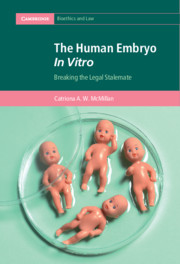Book contents
- The Human Embryo In Vitro
- Cambridge Bioethics and Law
- The Human Embryo In Vitro
- Copyright page
- Dedication
- Contents
- Foreword
- Acknowledgements
- Table of Cases
- Table of Legislation
- Abbreviations
- Introduction
- Part I Into Liminality
- 1 The Evolution of ‘the Embryo’ in Law
- 2 ‘The Embryo’ in Law Today
- 3 From Process to Purgatory
- Part II Through Liminality
- Part III Out of Liminality
- Bibliography
- Index
3 - From Process to Purgatory
Moving Beyond Legal Stasis
from Part I - Into Liminality
Published online by Cambridge University Press: 18 March 2021
- The Human Embryo In Vitro
- Cambridge Bioethics and Law
- The Human Embryo In Vitro
- Copyright page
- Dedication
- Contents
- Foreword
- Acknowledgements
- Table of Cases
- Table of Legislation
- Abbreviations
- Introduction
- Part I Into Liminality
- 1 The Evolution of ‘the Embryo’ in Law
- 2 ‘The Embryo’ in Law Today
- 3 From Process to Purgatory
- Part II Through Liminality
- Part III Out of Liminality
- Bibliography
- Index
Summary
We have seen thus far that the intellectual underpinning of the 1990 Act (as amended) - the embryo’s rather vague ‘special status’ - has not changed since the Act’s inception. Moreover, we have seen that any attempts change the intellectual basis of the Act, for example the 2008 Act, have been cautious at best. Thus, as a way of mapping the landscape to date, and also of clearing a path towards novel approaches to regulating the embryo, this chapter undertakes two important tasks: (1) an academic analysis of the caution mentioned above - a fade from discourse - which has only intensified the confusion surrounding the ‘special’ legal status of the embryo; and (2) an exploration of some of the ways in which the unclear nature, source, and extent of the legal status of the embryo could be clarified by exploring two key normative legal tools that are often employed to provide certainty: binding objects within a regulatory space, and drawing boundaries. Ultimately, this chapter posits that the root of the vague nature of the embryo’s ‘special status’ is a prevailing uncertainty regarding how we ought to treat embryos in vitro, because, by its very nature, it does not easily fit into normative social, moral or legal categories.
Keywords
- Type
- Chapter
- Information
- The Human Embryo In VitroBreaking the Legal Stalemate, pp. 71 - 96Publisher: Cambridge University PressPrint publication year: 2021



